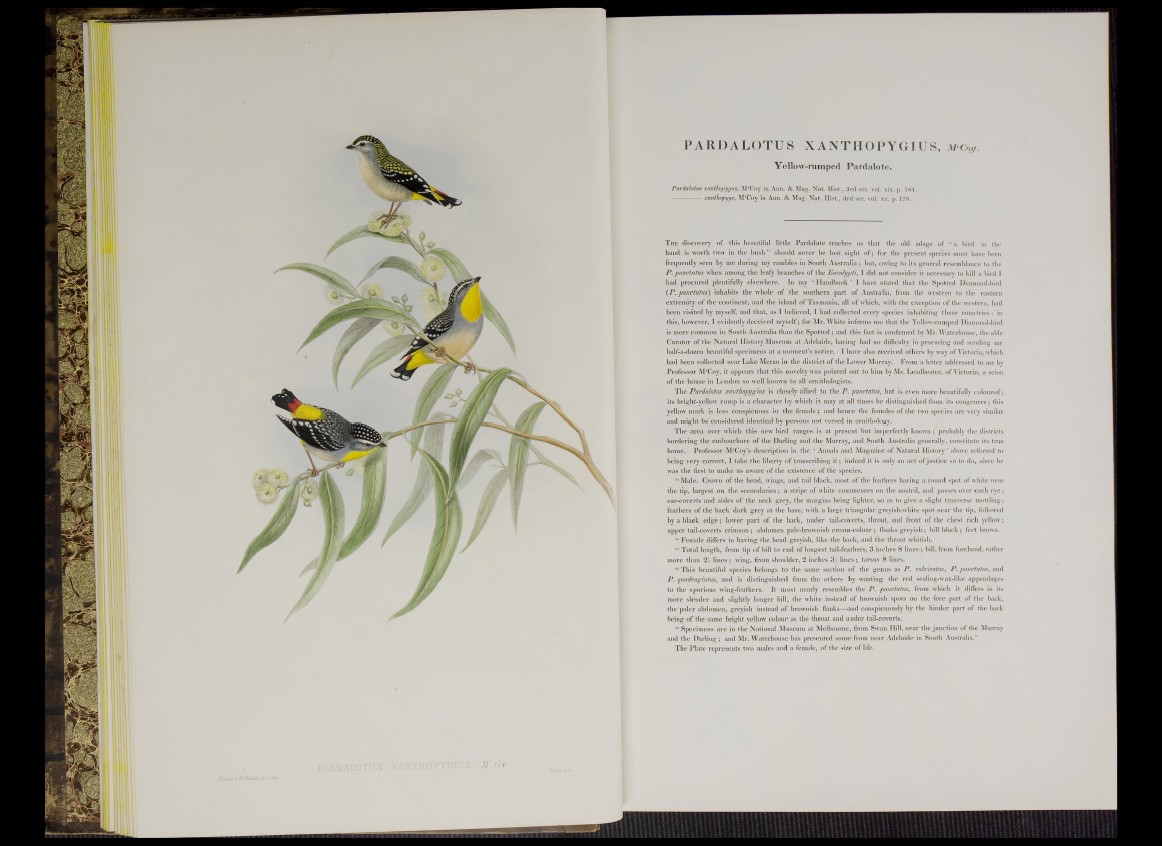
PARDALOTUS XANTHOPYGIUS, w c mj.
Yellow-rumped Pardalote.
Pardalotus xanthopygus, M‘Coy in Ann. & Mag. Nat. Hist., 3rd ser. vol. xix. p. 184.
---- xanthopyge, M‘Coy in Ann. & Mag. Nat. Hist., 3rd ser. vol. xx. p. 178.
T h e discovery of this beautiful little Pardalote teaches us that the old adage of “ a bird in the
hand is worth two in the bush ” should never be lost sight o f; for the present species must have been
frequently seen by me during my rambles in South Australia; but, owing to its general resemblance to the
P. punctatus when among the leafy branches of the Eucalypti, I did not consider it necessary to kill a bird 1
had procured plentifully elsewhere. In my ‘ Handbook ’ I have stated that the Spotted Diamond-bird
(P . punctatus) inhabits the whole of the southern part of Australia, from the western to the eastern
extremity of the continent, and the island of Tasmania, all of which, with the exception of the western, had
been visited by myself, and that, as I believed, I had collected every species inhabiting these countries : in
this, however, I evidently deceived myself; for Mr. White informs me that the Yellow-rumped Diamond-bird
is more common in South Australia than the Spotted ; and this fact is confirmed by Mr. Waterhouse, the able
Curator of the Natural History Museum at Adelaide, having had no difficulty in procuring and sending me
half-a-dozen beautiful specimens at a moment’s notice. I have also received others by way of Victoria, which
had been collected near Lake Meran in the district of the Lower Murray. From a letter addressed to me by
Professor M‘Coy, it appears that this novelty was pointed out to him by Mr. Leadbeater, of Victoria, a scion
of the house in London so well known to all ornithologists,.
The Pardalotus ocanthopygius is closely allied to the P. punctatus, but is even more beautifully coloured;
its bright-yellow rump is a character by which it may at all times be distinguished from its congeners; this
yellow mark is less conspicuous in the female; and hence the females of the two species are very similar
and might be considered identical by persons not versed in ornithology.
The area over which this new bird ranges is at present but imperfectly known; probably the districts
bordering the embouchure of the Darling and the Murray, and South Australia generally, constitute its true
home. Professor M‘Coy’s description in the ‘ Annals and Magazine of Natural History ’ above referred to
being very correct, I take the liberty of transcribing it; indeed it is only an act of justice so to do, since lie
was the first to make us aware of the existence of the species.
“ Male. Crown of the head, wings, and tail black, most of the feathers having a round spot of white near
the tip, largest on the secondaries; a stripe of white commences on the nostril, and passes over each eye;
ear-coverts and sides of the neck grey, the margins being lighter, so as to give a slight tranverse mottling;
feathers of the back dark grey at the base, with a large triangular greyish-white spot near the tip, followed
by a black edge; lower part of the back, under tail-coverts, throat, and front of the chest rich yellow;
upper tail-coverts crimson ; abdomen pale-brownish cream-colour ; flanks greyish ; bill black ; feet brown.
“ Female differs in having the head greyish, like the back, and the throat whitish.
“ Total length, from tip of bill to end of longest tail-feathers, 3 inches 8 lines ; bill, from forehead, rather
more than 2 i lines ; wing, from shoulder, 2 inches 3t lines; tarsus 8 lines.
“ This beautiful species belongs to the same section of the genus as P. rubricatus, P. punctatas, and
P. quadragmtus, and is distinguished from the others by wanting the red sealing-wax-like appendages
to the spurious wing-feathers. It most nearly resembles the P. punctatus, from which it differs in its
more slender and slightly longer bill, the white instead of brownish spots on the fore part of the back,
the paler abdomen, greyish instead of brownish flanks— and conspicuously by the hinder part of the back
being of the same bright yellow colour as the throat and under tail-coverts.
“ Specimens are in the National Museum at Melbourne, from Swan Hill, near the junction of the Murray
and the Darling; and Mr. Waterhouse has presented some from near Adelaide in South Australia.”
The Plate represents two males and a female, of the size of life.